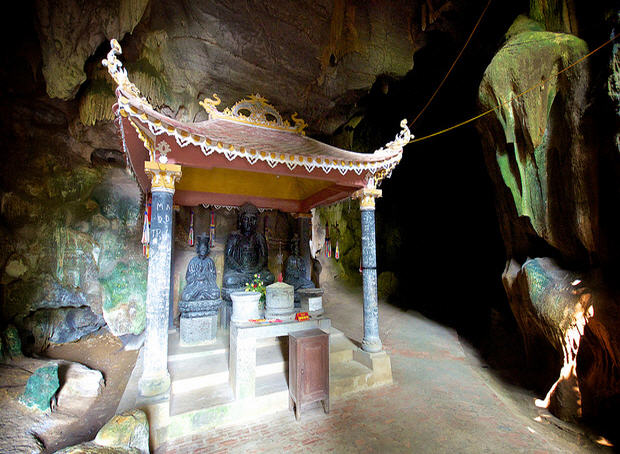Bich Dong Pagoda – The Jade Gem in the Sacred Land of Ninh Binh
Ninh Binh, with its pristine beauty of limestone mountains and the harmonious blend of nature and culture, harbors a sacred treasure amidst cliffs and lush foliage.
Bich Dong Pagoda, located in Ninh Binh, is an ancient temple built on a limestone mountain range. It is a historical and cultural monument within the Trang An landscape complex, recognized as a special national relic and UNESCO World Heritage Site. It is one of the renowned scenic spots of Ninh Binh province, often referred to as the “second most beautiful cave” in Vietnam, following Huong Tich Cave in Perfume Pagoda.

Bich Dong Pagoda holds a rich history and folklore, recounting its establishment centuries ago. It was initially formed in 1428 as a small temple atop the mountain. In 1705, two venerable monks named Tri Kien and Tri The from Nghia Hung district, Nam Dinh province, met and formed a bond as brothers. Both monks were devout and aimed to propagate Buddhism and build temples in various places. Impressed by the exquisite terrain of Bich Dong Mountain and the existing temple, they decided to settle here, renovating and expanding the temple into three tiers: Lower, Middle, and Upper, for meditation and practice.

The Lower Pagoda features ancient architecture and a serene atmosphere, with five chambers built on a raised platform at the mountain’s foothill. Inside the Buddha hall, the architecture follows the Dinh-style with wooden beams and pillars made from ironwood. The pagoda roof is curved in two tiers, comprising eight rooftops. The stone columns inside the Lower Pagoda are solid blocks, each over 4 meters tall.
Ascending 120 stone steps along a winding path to the middle of Ngoc Mountain leads to the Middle Pagoda. Just ahead, the words “Bich Dong” are carved into the mountain wall. This pagoda is uniquely integrated, partly in a cave and partly exposed to the sky, housing three Buddha chambers. About 6 meters above the Middle Pagoda is the Dark Cave, the main cavern, solemn and elongated, slightly tilting eastward. Within the Dark Cave hangs a large bell, cast in 1707 by the monks Tri Kien and Tri The, adding to the mythical charm of this stone-formed fairy tale world.
At the foot of the mountain flows the winding Ngoc Dong River, bordered by vast rice fields spreading into the distance.
Forty more stone steps along the mountain slope lead to the Upper Pagoda, also known as the East Pagoda, dedicated to Quan Am Bodhisattva. This pagoda sits at the highest point near the peak of Bich Dong Mountain. From the Upper Pagoda, one can view the five independent peaks known as Ngoc Nha Son, resembling five lotus petals, gazing towards Bich Dong Mountain.
The Upper Pagoda, positioned at the highest point, offers a sense of tranquility and peace.



In the year of Giap Ngo 1774, Lord Trinh Sam visited the pagoda and admired the panoramic view of mountains, caves, rivers, fields, and lush greenery. Impressed by the verdant scenery, he named the temple “Bich Dong,” symbolizing its convergence with the verdant background.
Bich Dong Pagoda, built in ancient architectural style, like other wooden pagodas, features tiled roofs without ridges, curving roofs, and gable corners resembling curved sword blades or the tail of a phoenix, making the roof undulating and graceful like tidal waves on water, appearing from a distance as a magnificent dragon boat or two wings of a bird spread wide in flight.


The pagoda is structured in the shape of the Chinese character “Tam,” vertically along the mountain slope, adapting to the mountainous terrain to create three separate pagodas: Lower, Middle, and Upper. Below the mountain lies the Thuy Xuyen Cave, 350 meters long, flowing along the mountain’s vertical axis, holding water within its depths.
The pagoda’s architecture features exquisite wood carvings, solemn altars, and ancient Buddha statues. The pagoda’s sanctuary houses a magnificent Gautama Buddha statue surrounded by bodhisattvas and guardian spirits, evoking reverence.

For those seeking a serene space, Bich Dong Pagoda is a destination worthy of a visit.
